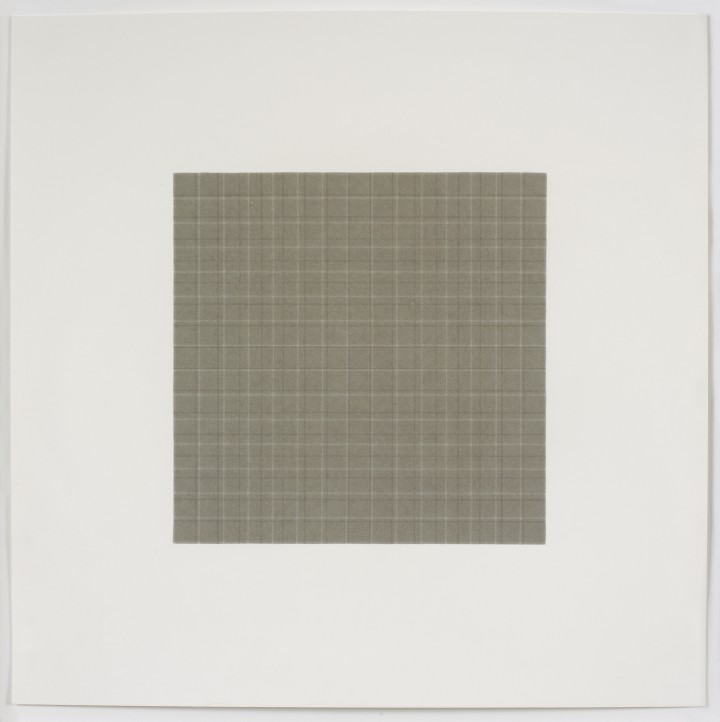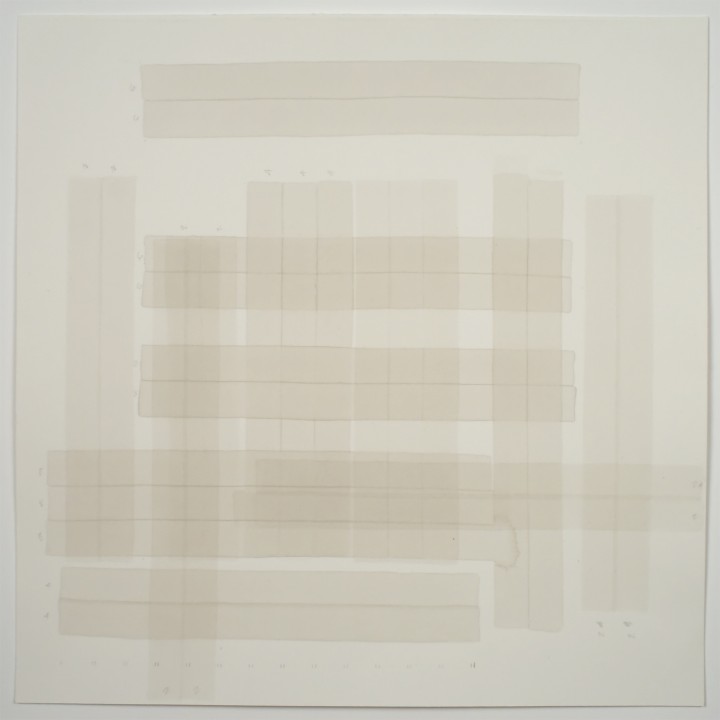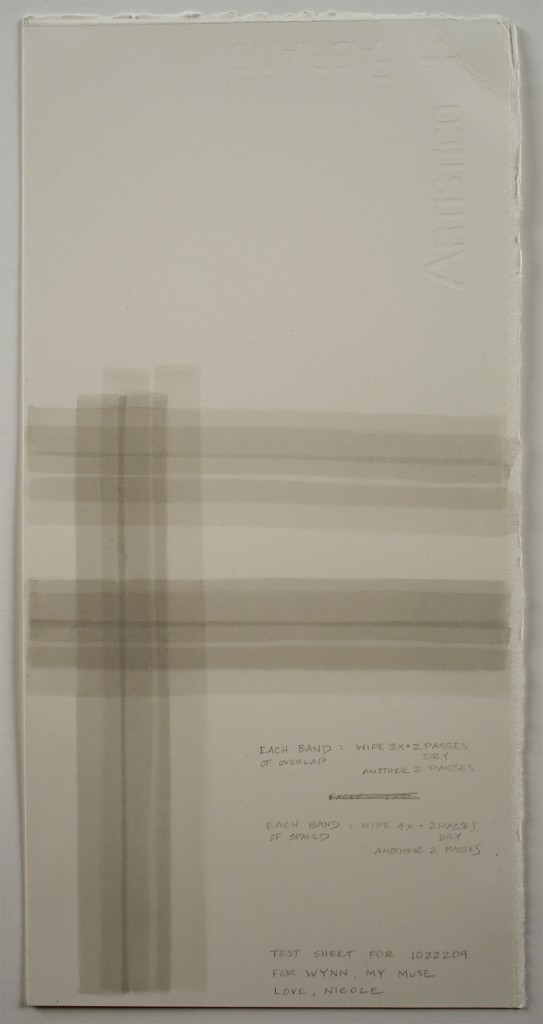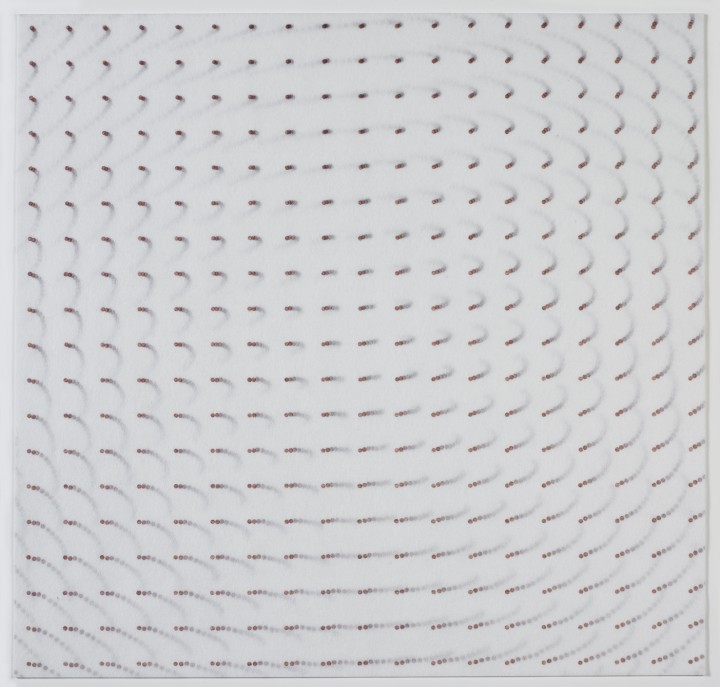
Figure 1. Nicole Phungrasamee Fein, #1042809, 2009
Watercolor on paper, 15 x 15 inches (38.1 x 38.1 cm)
© 2012 Nicole Phungrasamee Fein
Nicole Fein
In Conversation with Wynn Kramarsky & Rachel Nackman
March 2012, New York
Rachel Nackman: Can you tell us about the rhythm of making one of your drawings?
Nicole Fein: Slowing down is fundamental to what I do. I use processes that are technical, but the essence of the work is not the technique—it’s the process of slowing down and building something in a step-by-step, iterative manner. That is my approach to every day.
The slowing down comes from the very simple rituals of cutting the paper, setting it up, and doing tests on the test sheets. All those rituals bring me to a place from which I can make that first line.
Wynn Kramarsky: In making the initial decision to make a drawing, a particular drawing, do you think, “It’s nine o’clock on a Tuesday, and I have to make a drawing”? Or do you think, “I have to make a drawing, even though it’s nine o’clock on a Tuesday.” How disciplined are you? And how much of your work occurs because you suddenly feel that you must produce something?
NF: There’s a pressure that comes and goes—but it is like going to work. When it’s time to work, I am disciplined about bringing myself to that place.
WHK: Discipline of course can imply internal resistance. But you’re saying that your sense of discipline also makes you feel, “I must do this.”
NF: Yes, it’s both a discipline and a calling. Sometimes I can’t resist, like the times when I go downstairs to the studio—just to close up for the night—and something catches my eye, and before I know it, hours have passed and it is three in the morning.
RN: How long does it take you to make one of these drawings?
NF: The finished piece is ideally made in one sitting, but I make so many failed attempts that I don’t know whether to count those in the process of making one work—especially when I’ll complete one and it’s still not right.
RN: It could take anywhere from one sitting to several weeks of work to complete one drawing?
NF: Yes. And a sitting can last anywhere from a few hours to all day. The longest was fourteen hours straight.
RN: Can you tell us about the physical process of making each drawing?
NF: I can describe, first of all, the setup. My good friend Ed Green made me a beautiful large worktable. On the worktable is an adjustable easel. I used to draw bent over at a flat table, and it was really hard on my back and shoulders. I wanted to be upright. The easel that Ed designed allows me to turn the paper upside down to draw from both directions while also keeping the line I’m making at eye level. I start at the upper left-hand corner and move the brush from left to right, turn the board and the drawing upside down, and then go back over that line again, moving across the paper. A Velcro system allows me to adjust the height of the paper after every stroke. Through repetition, I get into a rhythm of drawing. But still, after many hours, standing or even sitting upright…I get tense and tired.
RN: Do you take breaks?
NF: I try not to take breaks. It’s best for the work that way. On a very intensive day, I won’t talk to anyone. I won’t eat very much. I try to avoid having to take a bathroom break. It’s rigorous.
RN: Do you have to prepare yourself in advance for that sort of endurance test?
NF: I don’t do anything specifically to prepare. I think it is different now than it was in the beginning, when I didn’t realize what would be required, and I would just get involved in a piece. Now that I know what it will take, it can be daunting, in the morning, to set out to do it, but…
RN: That’s when you approach the discipline that Wynn was talking about.
NF: Yes. Mentally it does require focus and patience, and I’ve often been asked whether it feels like a meditative process. I’ve never done strict meditation, but doing this kind of work requires absolute presence of mind, attention, and focus on the line at that moment. It does not leave me feeling refreshed at the end of the day. I feel completely depleted and exhausted. It’s not rejuvenating, as maybe meditation is.
One important thing to me, however, is that I do not want the drawings to feel labored over even though they are labored over. I want them to have a real sense of peace and calm, and I want them to simply appear on the paper.
WHK: When you finish a drawing and you decide, “Yes, this is a good one,” does that give you the kind of serenity that most of us experience when looking at your work?
NF: Sometimes it does, but sometimes it’s the opposite. I’ve completed a drawing and felt awful, like it’s just a disaster. This has happened a number of times, and I’ve come to bed in tears. And I wake up [my husband,] Mark, really upset, and he’ll have been rooting for me all day—hoping it goes well. I’ll tell him that the drawing is a failure. He’ll say, “Wait till tomorrow, wait till tomorrow, look at it again tomorrow.”
The next day it does look better, and the day after that it looks even better, and a week later maybe I can start to feel that sense of calm from it…. I’m learning to trust the process, to keep going even if it doesn’t seem like it’s going well. At its best, the practice brings calm.
RN: When you’re making a drawing, are you conscious of certain things that you need to do in order for it to turn out well?
NF: Absolutely. One of my long-running conflicts with myself is about trying to make a perfectly straight line. There’s some comfort in trying to maintain a straight line, but when I look at work that I’ve done, it’s the ones that aren’t so perfectly straight that I like most. Even though at the time, it seems like, “Oh no, I’m messing up!” Those pieces have a life…a feel that makes them more interesting for me, even though in the making it’s a challenge to allow myself to let go.

Figure 2. Nicole Phungrasamee Fein, Untitled (Test Sheet), 2009
Watercolor and graphite on paper, 14 3/4 x 14 3/4 inches (37.5 x 37.5 cm)
© 2012 Nicole Phungrasamee Fein
The untitled test sheet from 2009 (fig. 2) is very special because it captures one of those magical moments in the studio of discovering something unexpected. On a test sheet, I’m testing color, but I’m also testing line, figuring out how many passes I need to make in order to achieve the effect I want. Here I wasn’t paying close attention to how I laid down the lines; they overlapped, and I suddenly saw two different patterns coming together. Before that moment, it had never occurred to me to put one pattern on top of another. That idea opened up a whole new world of possibilities. The results were always surprising—more interesting than anything I could have deliberately planned. For the first time in my work, there was movement and rhythm. Before, everything had been very still.
I used the same idea to make 1042809, also from 2009 (fig. 1). In this drawing, the overlapping patterns ended up creating a central square, which was very exciting. I didn’t know that would happen when I was making the test sheet; as I was drawing, I could see it emerging.
RN: How many studies do you make before you begin working on a finished drawing?
NF: It’s usually one or two.
RN: Do you sit down to make a study with the idea that you’re going to make a specific drawing based on that study?
NF: Yes. But again they’re very sketchy. I don’t know what the drawing is really going to be like, even though I’ve figured out the spacing and the overlapping on the test sheet. I still don’t know what the final outcome will be.
RN: Once you’ve made a study, do you keep it by you while you’re making the drawing?

Figure 3. Nicole Phungrasamee Fein, Untitled (Test Sheet), 2009
Watercolor on paper, 15 x 7 3/8 inches (38.1 x 18.7 cm)
© 2012 Nicole Phungrasamee Fein
NF: I make a test sheet to understand the patterns I want to use, and then I use those studies to apply guiding marks to the larger drawing paper. Those marks are removed once the work is complete. But I don’t refer directly to the study once I’ve started working. At that point, my total focus is on the line of the moment.
RN: Is the pattern that you devise before making each drawing a way of being decisive in advance, so that then you can be focused without having to make decisions?
NF: Yes.
RN: What do you find challenging about making these drawings?
NF: There’s really no room for error in my process, so a good drawing is rare. I have to try not to get discouraged, because so many of them don’t come out right. I just have to start over.
RN: It’s an apt metaphor for daily life.
NF: Yes, that’s true.
RN: Can you tell us about how you came up with the idea for Coriolis (2010; fig. 4)?
NF: Yes, I would love to tell you. Because there were so many woven patterns in the watercolors I was making around that time, I started thinking about textiles and decided to learn how to sew. One day I went to the fabric store with a tunic that I wanted to copy. The woman there gave me what she said was patternmaking material, and I spent that weekend on my hands and knees in the studio, trying to draw a pattern. The patternmaking material was covered in red dots—a dot matrix. I was surrounded by dots, and the material was semitransparent, so the dots were coming in and out and all around me…. I quickly lost interest in the idea of trying to make something to wear. I thought: “This is great material. I should do something with this.” I started to play with layering it. I thought: “This is preprinted material! It’ll save so much time.” Well, I quickly realized that it’s mass-produced, so the dots aren’t printed perfectly.
WHK: The register is bad.
NF: The register is bad, and in order to align them on top of each other…it just wasn’t going to work. I realized I would have to draw all my own dots. [Sigh.] Which is of course so much more true to my nature and way of doing things. I started searching for the right material to use, and as has happened countless times over the years, Ed Green arrived at my studio with a roll of Holotex, which is a polyester material. Ed also made me some wooden drawing tools, which I used to stamp the ink onto the Holotex. I would apply color to the tool and then stamp it down to make each dot.
I started to play with the arrangement of the Holotex sheets, and I kept thinking, “How am I going to hold these sheets together?” I wanted to stick them together, but I didn’t want the adhesive to show. I realized that I had only the space of the dots under which to hide adhesive, so I made a double-sided tape dot for every single drawn dot, using a Japanese screw punch.
Play to hear Nicole Phungrasamee Fein speaking about the discovery of her work Coriolis.

Figure 4. Nicole Phungrasamee Fein, Coriolis, 2010
Ink and tape on polyester, 18 3/4 x 18 3/4 inches (47.6 x 47.6 cm) © 2012 Nicole Phungrasamee Fein
The original idea for Coriolis was that the dots would rotate around the center. That was what I wanted to see happen. I had arrayed all of my sheets after months of preparation, with the dots and all the tape on them. One day, when I thought I was ready to remove the release paper from the double-stick tape and actually adhere all of it, I started to move the stack, and the sheets slipped from my fingers. They arrayed themselves into Coriolis by chance. I was stunned—in awe and just silent. I couldn’t move. I stood there looking at this pattern; I didn’t know what it was, and I didn’t understand it.
I quietly tiptoed upstairs and whispered to Mark and [my son,] Felix: “Something just happened in the studio. You have to come and see.” We looked at it together, and we didn’t understand what it was, but it was far more interesting than what I had been planning to do. For days, I stood and looked at it. I studied it and tried to figure it out, tried to understand it enough to intentionally do it. Yet I only had those sheets prepared to work with, so one by one, I started removing them to remake Coriolis.
WHK: That’s amazing, because you probably had a fairly square original pattern for it.
NF: Yes, my plan was perfectly symmetrical and very predictable. In Coriolis, there’s no center of gravity. There’s no single point around which the dots rotate. Some recede and some come forward.
RN: They array themselves within a very three-dimensional space.
NF: Yes.
RN: There’s a meditative and infinite feeling to looking down into Coriolis that references, in a lot of ways, your watercolors—but in a more dimensional way.
NF: Yes, within a deeper space…
RN: Is your work a sort of diaristic exercise?
NF: Yes, it is. The title of each work is the date of its completion—just a way of marking for myself at what point in my life I made each one.
While the test sheets are notations for formal drawings, all the works are notations for my life. The finished works show something about my state of being on a particular day; the individual lines record the moments.
RN: Do you find that there’s a correlation between the drawings that you consider failed and a certain way that you feel?
NF: Yes, I think so. It depends on why a drawing has failed, but oftentimes it’s because I wasn’t feeling steady or able to focus enough—or to slow down enough.
RN: Are you trying to slow your life down enough to make each drawing, or do you make each drawing because you want to slow down?
NF: I draw in order to slow myself down. The practice of drawing keeps me centered. We have gotten very busy, and I hope that I can bring a sense of slowing down to other areas of my life. I feel like the world we live in right now moves so quickly, and there are so many different directions to go in every day. I am truly blessed that my life is filled with a loving family, dear friends, and lots of fun, but I do treasure my studio time. My goal is to be present and attuned to whomever I am with and whatever I am doing.
RN: Is there something about drawing daily that helps you?
NF: Drawing is always better when it’s a daily practice. I take any window of time that I can. That time becomes sacred. The rituals of the practice help to quiet my mind.
I’ve found that when drawing is a daily practice I have a good rhythm that creates a momentum. The work develops and evolves much more readily than it does if I’ve taken a break. But when I do take time off, I return with a greater appreciation for the practice. I see the work with fresh eyes. This new perspective brings a welcome shift.
RN: Do you have a sense of how the patterns you make have evolved from earlier pieces to the present?
NF: The very first patterns were the simplest, the most basic: one line touched the next line, and a field was made out of these lines touching. One day, I turned the paper ninety degrees and crossed over those lines, and a grid appeared. Every drawing since then has been another iteration, a variation on that idea: changing the spacing of the overlapping, changing the width of the line…. Each one comes after the next. I’ll see something happen in one drawing, and it’ll spark something I use in the next.
RN: The patterns you develop are based on things you observe while making your drawings?
NF: Yes, and while working things out on the test sheets. One drawing leads to the next as a natural progression.
RN: Where do you see these patterns going, or do you feel that they have fully arrived?
NF: Every time I feel that I’ve arrived, they evolve. Something shifts that takes me in a new direction. But at the same time, I feel like I’m doing the exact same thing I’ve always done—and that is one line after another.
I do keep coming back to the simplest drawings, in which each line touches the edge of the previous line. Those drawings keep me grounded. They are the essence of my practice. So perhaps the very first one had fully arrived.
Play to hear Nicole Phungrasamee Fein speaking about the “slowness” of her process in conversation with Wynn Kramarsky.
Notes
Nicole Phungrasamee Fein
Wynn Kramarsky
Rachel Nackman

